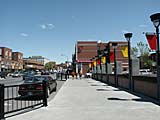13.2
Promote pedestrian travel through improved public space design
The City recognizes the importance of pedestrians and the need to design public spaces accordingly. Every day Montrealers enjoy the benefits of walking, help make the City livelier and minimize the emission of pollutants by doing much of their travel on foot. Moreover, travelling by car, public transportation or bicycle all includes some walking.
 Montréal already offers a friendly urban environment that generally allows for the safe and healthy coexistence of pedestrian and vehicle traffic. While the underground pedestrian network provides an alternative to the Centre's sidewalks, particularly appreciated in winter, the City places a priority on the quality of pedestrian routes and the liveliness of the public realm no matter the season. The construction of pedestrian skywalks over public spaces is therefore incompatible with the enhancement of the public realm, apart from the negative consequences they would have on Montréal's urban landscape and architectural heritage.
Montréal already offers a friendly urban environment that generally allows for the safe and healthy coexistence of pedestrian and vehicle traffic. While the underground pedestrian network provides an alternative to the Centre's sidewalks, particularly appreciated in winter, the City places a priority on the quality of pedestrian routes and the liveliness of the public realm no matter the season. The construction of pedestrian skywalks over public spaces is therefore incompatible with the enhancement of the public realm, apart from the negative consequences they would have on Montréal's urban landscape and architectural heritage.
Many areas of Montréal that are designed on a human scale have exemplary characteristics that make walking safe, comfortable, efficient and stimulating.
In contrast, certain areas that are designed to facilitate automobile traffic are unappealing and often hazardous for pedestrians.
These areas usually have the following characteristics:
- Lack or excess of street furniture;
- Lack of vegetation;
- Sidewalks that are too narrow, in poor condition or nonexistent;
- Excessively wide roadways;
- Pedestrian routes that cross areas designed for cars (overpasses, interchanges, large parking lots, etc.).
Certain practices, such as permitting right turns on red lights (currently illegal throughout the City), can aggravate the pedestrian's feeling of discomfort and lack of safety.
Implementation measures
- Design public spaces in accordance with the stated design principles (see Design Principles for the Public Realm).
- Prepare a design guide for public roads that identifies parameters for traffic and facilities with a view to harmonizing or redesigning the geometry of certain streets and intersections.
- Harmonize the dimensions of streets with excessively wide roadways, particularly when doing road repairs, so as to improve pedestrian safety and comfort: wider sidewalks, tree planting and better lighting.
- Study the potential of pedestrianizing, permanently or temporarily, certain road segments after an analysis of the potential impacts on the balance of other urban activities and the quality of life of those living nearby.
- Establish coordination among major occupants of public property (STM, Bell, Canada Post, etc.) and the various municipal departments concerned with a view to a more rational use of sidewalks and roadways.